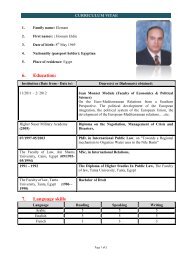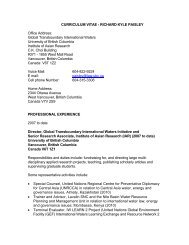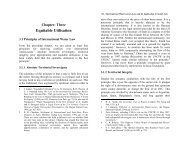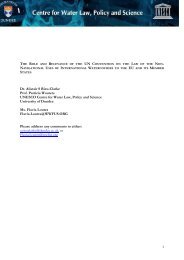Upreti, Trilochan, International Watercourses Law and Its Application ...
Upreti, Trilochan, International Watercourses Law and Its Application ...
Upreti, Trilochan, International Watercourses Law and Its Application ...
You also want an ePaper? Increase the reach of your titles
YUMPU automatically turns print PDFs into web optimized ePapers that Google loves.
Legality River Linking Project / 259 260 / <strong>International</strong> <strong>Watercourses</strong> <strong>Law</strong> <strong>and</strong> <strong>Its</strong> <strong>Application</strong> in South Asiaelection time. Once the elections are over, <strong>and</strong> the leaders <strong>and</strong>parties get elected, they tend to forget people’s miseries <strong>and</strong> goabout business as usual for personal or partisan gains. The fewworks that get done to ameliorate the situation are far fromadequate to cope with this enormous task.3 The littlecompensation or relief provided in the aftermath of thecalamities is always insufficient. The compulsions of the rulingelite in not being able to resolve these formidable challengesneed to be understood before arriving at a substantialconclusion <strong>and</strong> blaming someone without sufficientunderst<strong>and</strong>ing. The other point of significance is that the lack ofcooperation between states, either members of a federation orsovereign nations, has become the cause of suffering for all thepeople of the SAARC Quadrangle. 4The basic point from the view of hydrology <strong>and</strong> internationallaw is that a watercourse should be taken as a single entity,from its origins in the high Himalayas of Tibet to the point ofits drainage into the Ocean. Moreover, it is a rule of nature <strong>and</strong>the watercourse itself. Therefore, a nation or a state could notclaim such watercourse as its national wealth alone but as apartner or a member of the basin. Thus, any development,allocation <strong>and</strong> sharing from such a shared watercourse shouldbe undertaken in such a way that every state’s share will not beinfringed upon, nor any harm <strong>and</strong> injury caused to it from suchuse <strong>and</strong> everyone should be benefited equitably. The<strong>International</strong> Court of Justice in its judgment of 1937 in theRiver Oder case resolved these issues forever, <strong>and</strong> since then,this concept has received universal recognition <strong>and</strong> is regardedas a rule of customary international law. 5 Against thiscontextual setting, Bangladesh could not claim the3 D. Gyawali, Water in Nepal, Kathm<strong>and</strong>u: Himal Books, 2001, pp. 87-135.4 B. G. Verghese, Waters of Hope, Oxford & IBH Pub., New Delhi,1990, p. 374.5 Denmark, Germany, France, Great Britain, Sweeten, Czechoslovakia v.Pol<strong>and</strong>, PCIJ Report 1937. pp. 221-222.Brahmaputra or India the Ganges, or Nepal the Kosi or Bhutanthe Sunkos, as a solely national river <strong>and</strong> do whatever it wishedto fulfill the requirement within one’s territory only. This basicconcept <strong>and</strong> framework has been largely ignored by the nations,which should be seen as the crux of the problem in the sharing<strong>and</strong> allocation of shared watercourses among the nations <strong>and</strong>developing projects unilaterally against the core theme ofinternational law. As a major partner of these watercourses, ifwe study the law <strong>and</strong> tradition within India in its interstatewater conflicts, such concepts <strong>and</strong> views have beenunanimously accepted <strong>and</strong> widely practiced. For instance,Godawari River Water dispute, Cauvery River Water dispute<strong>and</strong> other disputes are the living testimonials of this area. Onecould question how India could behave or expect to acceptconditions of allocation <strong>and</strong> sharing of waters which are againstthe norms that it has already been practicing, whether in itsdispute with Pakistan pertaining to the Indus River Treaty,inter-state disputes or the accepted norms in relation with thethen east Pakistan pertaining to the Karmaphuli river- along theAsam-Meghalaya border. 6Much has transpired since then <strong>and</strong> so has the politicalenvironment of south Asia. Moreover, many things havechanged since the Koshi <strong>and</strong> G<strong>and</strong>ak river treaties with Nepalin the 1960s, the 1975 treaty on the commission of the Farakkabarrage, the 1977 Ganges treaty <strong>and</strong> so forth. There isdemocracy with democratic institutions in the SAARCQuadrangle, which has altered the structure of governance <strong>and</strong>the power base of the governments as well. In this context, it isnot only the governments that should be heard but also civilsocieties, NGOs, INGOs <strong>and</strong> a host of stakeholders, whoseconcerns must also be accommodated. That is to say, amonopolistic <strong>and</strong> hegemonistic approach is no more palatableor tolerated so that democratic norms should somehow befollowed. Such changes in mindsets can be witnessed6 T. <strong>Upreti</strong>, "Inundation problem in Indo-Nepal Relations" April 29(2004), The Kathm<strong>and</strong>u Post.












